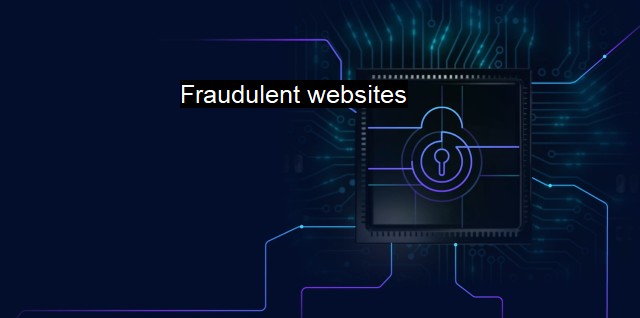What are Fraudulent websites?
Phishing Websites: The Evolving Threat to Online Security and How to Spot Them
Fraudulent websites refer to locations on the web created with the primary intent to deceive users into sharing sensitive personal information, or into downloading malware or other harmful computer software. These sites are counted among the modern threats to cybersecurity that have the potential to infect devices, compromise data security, and even damage the critical digital infrastructure of corporations and countries.A fraudulent website typically impersonates a legitimate establishment such as a financial institution or a known commercial entity. The goal is to make an unsuspecting visitor believe they are interacting with a credible and safe online environment. A common strategy employed by these fraudulent sites focuses on spoofing, which refers to the act of faking the identity of a user, device or client on the internet. Web spoofing involves creating an almost identical copy of a legitimate website, even down to getting the color scheme, layout, graphics, logos and content.
Once enticed onto the purportedly trustworthy site, users may be asked to enter sensitive personal information such as credit card details, social security numbers, or login credentials. This information is then captured by the perpetrators behind the fraudulent website, leading to identity theft, financial fraud and other cybercrimes. Cybercriminals also embed traps for users to unknowingly download malware or dangerous software onto their devices, effectively turning them into entry points for further cyberattacks.
There is also the risk of phishing, another commonly used technique by fraudulent websites. A phishing website is created to look like a familiar online platform, and users are often directed to it via an email or a text message that seems, on the surface, to be from a legitimate source. Unknowing victims key in their credentials, inadvertently handing them over to the fraudsters.
Given the potential for harm by fraudulent websites, many technological countermeasures have been developed to detect and deal with them. Cybersecurity systems including antivirus software play a crucial role in this ongoing work. They can detect unusual behavior or suspicious signatures that are typically linked with phishing or other types of fraudulent sites, and immediately alert the user, counteracting the effects before damage could be done. they can monitor network traffic, continually inspect incoming emails and periodically scan the device for installed malicious software.
An added layer of protection comes from web browsers which have started using additional indicators like showing a padlock icon to indicate a secure connection or the use of HTTPS (Secure HTTP). By using encrypted communication protocols, they offer a certain level of assurance against fraudulent activities and malicious attacks.
The growing reliance on digital technology and increasing sophistication of cybercriminals make the existence of fraudulent websites an ever-present threat. Cybersecurity measures including antivirus software constantly evolve to counter this challenge, thus, making user awareness and caution just as important. Internet users need to verify the security of the sites they visit and be careful about sharing personal information.
Fraudulent websites pose a significant threat to cybersecurity, whether as an individual user or at an organizational level. As cybercriminals continue to find new ways and means to orchestrate fraud, cybersecurity measures and antivirus software also adapt to enforce protection against these fraudulent websites and ensure safe navigation in the digital space. This continual evolution is hence an inherent part of the broader landscape of cybersecurity.

Fraudulent websites FAQs
What are fraudulent websites?
Fraudulent websites are websites that are designed to deceive users into giving personal or financial information or downloading malware. They often appear to be legitimate websites, but they are actually created by scammers to steal information or money from unsuspecting victims.How can I identify a fraudulent website?
Fraudulent websites often use phishing techniques to trick users into providing sensitive information, such as passwords and credit card numbers. To identify a fraudulent website, look for clues such as misspelled URLs, unsecured connections, suspicious pop-ups, and requests for personal information that seem unusual or unnecessary.What should I do if I encounter a fraudulent website?
If you encounter a fraudulent website, do not enter any personal information or download any files from the site. Instead, close the site and report it to your antivirus software or the appropriate authorities. It's important to protect your personal information and financial accounts from fraud, so take any necessary steps to secure your accounts and monitor your credit report for any suspicious activity.How can I protect myself from fraudulent websites?
To protect yourself from fraudulent websites, use trusted antivirus software that can detect and block malicious websites. Be cautious when clicking on links or downloading files from unfamiliar websites, and always verify the authenticity of a website before entering any personal or financial information. Additionally, keep your operating system and web browser up-to-date with security patches and updates to prevent vulnerabilities that can be exploited by hackers.| | A | | | B | | | C | | | D | | | E | | | F | | | G | | | H | | | I | | | J | | | K | | | L | | | M | |
| | N | | | O | | | P | | | Q | | | R | | | S | | | T | | | U | | | V | | | W | | | X | | | Y | | | Z | |
| | 1 | | | 2 | | | 3 | | | 4 | | | 7 | | | 8 | | |||||||